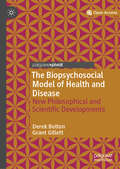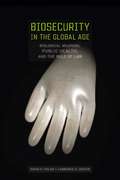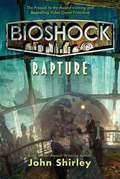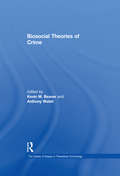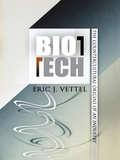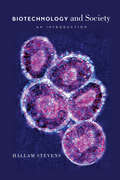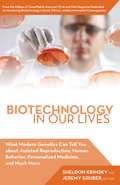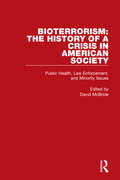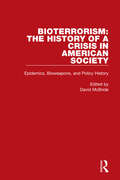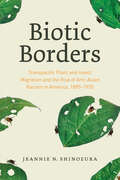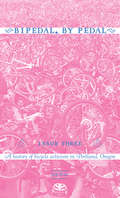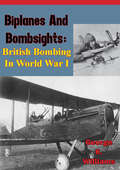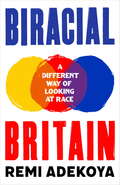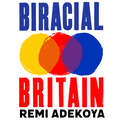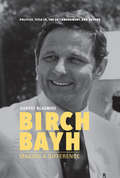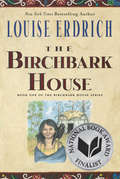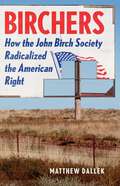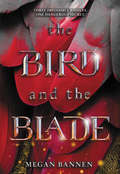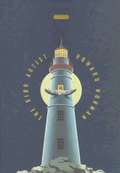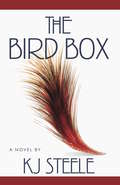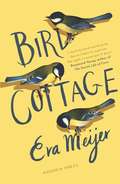- Table View
- List View
The Biopsychosocial Model of Health and Disease: New Philosophical and Scientific Developments
by Derek Bolton Grant GillettThis open access book is a systematic update of the philosophical and scientific foundations of the biopsychosocial model of health, disease and healthcare. First proposed by George Engel 40 years ago, the Biopsychosocial Model is much cited in healthcare settings worldwide, but has been increasingly criticised for being vague, lacking in content, and in need of reworking in the light of recent developments. The book confronts the rapid changes to psychological science, neuroscience, healthcare, and philosophy that have occurred since the model was first proposed and addresses key issues such as the model’s scientific basis, clinical utility, and philosophical coherence. The authors conceptualise biology and the psychosocial as in the same ontological space, interlinked by systems of communication-based regulatory control which constitute a new kind of causation. These are distinguished from physical and chemical laws, most clearly because they can break down, thus providing the basis for difference between health and disease. This work offers an urgent update to the model’s scientific and philosophical foundations, providing a new and coherent account of causal interactions between the biological, the psychological and social.
Biosecurity in the Global Age
by David P. Fidler Lawrence O. GostinFidler (law, Indian U. School of Law) and Gostin (global health law, Georgetown U. ) believe the US needs to formulate effective "biosecurity" policy to confront the twin threats of biological weapons and naturally occurring infectious disease. Proper formulation of this policy would involve a melding of traditional security policy and public health policy and would involve supervision of scientific endeavors in support of policy goals. Furthermore, it must be grounded firmly in the rule of law, they argue, and involve global governance. Annotation ©2008 Book News, Inc. , Portland, OR (booknews. com)
BioShock: Rapture
by John ShirleyConsidered to be one of the finest games in the history of interactive entertainment, "BioShock" features fascinating characters, intelligent enemies, and complex moral choices. For the first time, this amazingly complex and frightening world is explored in novel form.
Biosocial Theories of Crime
by KevinM. BeaverBiosocial criminology is an emerging perspective that highlights the interdependence between genetic and environmental factors in the etiology of antisocial behaviors. However, given that biosocial criminology has only recently gained traction among criminologists, there has not been any attempt to compile some of the "classic" articles on this topic. Beaver and Walsh's edited volume addresses this gap in the literature by identifying some of the most influential biosocial criminological articles and including them in a single resource. The articles covered in this volume examine the connection between genetics and crime, evolutionary psychology and crime, and neuroscience and crime. This volume will be a valuable resource for anyone interested in understanding the causes of crime from a biosocial criminological perspective.
Biosphere Politics: A New Consciousness for a New Century
by Jeremy RifkinThe post-modern world of the 21st century, where our personal and public lives are transformed, reflecting a whole new way of thinking and acting in the world.
Biotech
by Eric J. VettelThe seemingly unlimited reach of powerful biotechnologies and the attendant growth of the multibillion-dollar industry have raised difficult questions about the scientific discoveries, political assumptions, and cultural patterns that gave rise to for-profit biological research. Given such extraordinary stakes, a history of the commercial biotechnology industry must inquire far beyond the predictable attention to scientists, discovery, and corporate sales. It must pursue how something so complex as the biotechnology industry was born, poised to become both a vanguard for contemporary world capitalism and a focal point for polemic ethical debate.In Biotech, Eric J. Vettel chronicles the story behind genetic engineering, recombinant DNA, cloning, and stem-cell research. It is a story about the meteoric rise of government support for scientific research during the Cold War, about activists and student protesters in the Vietnam era pressing for a new purpose in science, about politicians creating policy that alters the course of science, and also about the release of powerful entrepreneurial energies in universities and in venture capital that few realized existed. Most of all, it is a story about people--not just biologists but also followers and opponents who knew nothing about the biological sciences yet cared deeply about how biological research was done and how the resulting knowledge was used.Vettel weaves together these stories to illustrate how the biotechnology industry was born in the San Francisco Bay area, examining the anomalies, ironies, and paradoxes that contributed to its rise. Culled from oral histories, university records, and private corporate archives, including Cetus, the world's first biotechnology company, this compelling history shows how a cultural and political revolution in the 1960s resulted in a new scientific order: the practical application of biological knowledge supported by private investors expecting profitable returns eclipsed basic research supported by government agencies.
Biotechnology and Society: An Introduction
by Hallam StevensWith Biotechnology and Society, Hallam Stevens offers an up-to-date primer to help us understand the interactions of biotechnology and society and the debates, controversies, fears, and hopes that have shaped how we think about bodies, organisms, and life in the twenty-first century. Stevens addresses such topics as genetically modified foods, cloning, and stem cells; genetic testing and the potential for discrimination; fears of (and, in some cases, hopes for) designer babies; personal genomics; biosecurity; and biotech art. Taken as a whole, the book presents a clear, authoritative picture of the relationship between biotechnology and society today, and how our conceptions (and misconceptions) of it could shape future developments. It is an essential volume for students and scholars working with biotechnology, while still being accessible to the general reader interested in the truth behind breathless media accounts about biotech's promise and perils.
Biotechnology in Our Lives: What Modern Genetics Can Tell You about Assisted Reproduction, Human Behavior, and Personalized Medicine, and Much More
by Sheldon Krimsky Jeremy GruberFor a quarter of a century, the Council for Responsible Genetics has provided a unique historical lens into the modern history, science, ethics, and politics of genetic technologies. Since 1983 the Council has had leading scientists, activists, science writers, and public health advocates researching and reporting on a broad spectrum of issues, including genetically engineered foods, biological weapons, genetic privacy and discrimination, reproductive technologies, and human cloning.Biotechnology in Our Lives examines how these issues affect us daily whether we realize it or not. Written for the nonscientist, it looks at the many applications of genetics on the world around us by posing questions such as:What should we know about genetics and childbirth?Can our genes keep us from qualifying for health insurance?Can gene therapy cure cancer?Is behavior genetically determined?Why would the FBI want our genes?Are foreign genes in our food?And much moreUltimately, this definitive book on the subject also encourages us to think about the social, environmental, and moral ramifications of where this technology is taking us.
Bioterrorism: Public Health, Law Enforcement, and Minority Issues (Bioterrorism: The History of a Crisis in American Society)
by David McBrideOriginally published in 2003 and now reissued with a new introduction, this collection provides an invaluable, academic resource on the challenges bioterrorism posed for American society and institutions. Critically selected essays from a wide range of disciplines document and analyze the problems and implications for political, economic, and legal institutions, as well as the challenges a weapon of disease and fear can impose on public health and public policy. By placing bioterrorism into its historical context, this collection also traces the academic research and historical decisions that have contributed to the formation of American policies attempting to cope with a potentially catastrophic attack on the population in general and urban population in particular.
Bioterrorism: Epidemics, Bioweapons, and Policy History (Bioterrorism: The History of a Crisis in American Society)
by David McBrideOriginally published in 2003 and now reissued with a new introduction, this collection provides an invaluable, academic resource on the challenges bioterrorism posed for American society and institutions. Critically selected essays from a wide range of disciplines document and analyze the problems and implications for political, economic, and legal institutions, as well as the challenges a weapon of disease and fear can impose on public health and public policy. By placing bioterrorism into its historical context, this collection also traces the academic research and historical decisions that have contributed to the formation of American policies attempting to cope with a potentially catastrophic attack on the population in general and urban population in particular.
Biotic Borders: Transpacific Plant and Insect Migration and the Rise of Anti-Asian Racism in America, 1890–1950
by Jeannie N. ShinozukaA rich and eye-opening history of the mutual constitution of race and species in modern America. In the late nineteenth century, increasing traffic of transpacific plants, insects, and peoples raised fears of a "biological yellow peril" when nursery stock and other agricultural products shipped from Japan to meet the growing demand for exotics in the United States. Over the next fifty years, these crossings transformed conceptions of race and migration, played a central role in the establishment of the US empire and its government agencies, and shaped the fields of horticulture, invasion biology, entomology, and plant pathology. In Biotic Borders, Jeannie N. Shinozuka uncovers the emergence of biological nativism that fueled American imperialism and spurred anti-Asian racism that remains with us today. Shinozuka provides an eye-opening look at biotic exchanges that not only altered the lives of Japanese in America but transformed American society more broadly. She shows how the modern fixation on panic about foreign species created a linguistic and conceptual arsenal for anti-immigration movements that flourished in the early twentieth century. Xenophobia inspired concerns about biodiversity, prompting new categories of “native” and “invasive” species that defined groups as bio-invasions to be regulated—or annihilated. By highlighting these connections, Shinozuka shows us that this story cannot be told about humans alone—the plants and animals that crossed with them were central to Japanese American and Asian American history. The rise of economic entomology and plant pathology in concert with public health and anti-immigration movements demonstrate these entangled histories of xenophobia, racism, and species invasions.
Biotic Borders: Transpacific Plant and Insect Migration and the Rise of Anti-Asian Racism in America, 1890–1950
by Jeannie N. ShinozukaA rich and eye-opening history of the mutual constitution of race and species in modern America. In the late nineteenth century, increasing traffic of transpacific plants, insects, and peoples raised fears of a "biological yellow peril" when nursery stock and other agricultural products shipped from Japan to meet the growing demand for exotics in the United States. Over the next fifty years, these crossings transformed conceptions of race and migration, played a central role in the establishment of the US empire and its government agencies, and shaped the fields of horticulture, invasion biology, entomology, and plant pathology. In Biotic Borders, Jeannie N. Shinozuka uncovers the emergence of biological nativism that fueled American imperialism and spurred anti-Asian racism that remains with us today. Shinozuka provides an eye-opening look at biotic exchanges that not only altered the lives of Japanese in America but transformed American society more broadly. She shows how the modern fixation on panic about foreign species created a linguistic and conceptual arsenal for anti-immigration movements that flourished in the early twentieth century. Xenophobia inspired concerns about biodiversity, prompting new categories of “native” and “invasive” species that defined groups as bio-invasions to be regulated—or annihilated. By highlighting these connections, Shinozuka shows us that this story cannot be told about humans alone—the plants and animals that crossed with them were central to Japanese American and Asian American history. The rise of economic entomology and plant pathology in concert with public health and anti-immigration movements demonstrate these entangled histories of xenophobia, racism, and species invasions.
Biotic Borders: Transpacific Plant and Insect Migration and the Rise of Anti-Asian Racism in America, 1890–1950
by Jeannie N. ShinozukaA rich and eye-opening history of the mutual constitution of race and species in modern America. In the late nineteenth century, increasing traffic of transpacific plants, insects, and peoples raised fears of a "biological yellow peril" when nursery stock and other agricultural products shipped from Japan to meet the growing demand for exotics in the United States. Over the next fifty years, these crossings transformed conceptions of race and migration, played a central role in the establishment of the US empire and its government agencies, and shaped the fields of horticulture, invasion biology, entomology, and plant pathology. In Biotic Borders, Jeannie N. Shinozuka uncovers the emergence of biological nativism that fueled American imperialism and spurred anti-Asian racism that remains with us today. Shinozuka provides an eye-opening look at biotic exchanges that not only altered the lives of Japanese in America but transformed American society more broadly. She shows how the modern fixation on panic about foreign species created a linguistic and conceptual arsenal for anti-immigration movements that flourished in the early twentieth century. Xenophobia inspired concerns about biodiversity, prompting new categories of “native” and “invasive” species that defined groups as bio-invasions to be regulated—or annihilated. By highlighting these connections, Shinozuka shows us that this story cannot be told about humans alone—the plants and animals that crossed with them were central to Japanese American and Asian American history. The rise of economic entomology and plant pathology in concert with public health and anti-immigration movements demonstrate these entangled histories of xenophobia, racism, and species invasions.
Bipedal, By Pedal: A history of bicycle activism in Portland, Oregon
by Joe BielIt's the second issue of the Expozine Award Winning Bipedal, By Pedal. Last time around we got a social history and tactics lesson about the Critical Mass bicycle activist movement. For this issue BPBP editor Joe Biel collected legal documents pertaining to the Portland Police Department's "interest" in the local Critical Mass movement. Obtained by Freedom of Information Requests, Biel shows through once-secret police and court documents that Portland Critical Mass may not have simply died out, rather "From reading their internal files, the Portland Police department was highly wary of Critical Mass from day one and went as far as illegally spying on the group with their anti-communist "Red Squad" and forever cementing the meme that Critical Mass' goals were rioting, blocking traffic, and antagonism with the public. " Portland is, of course, one of the best North American cities for cycling. This zine is a rally call for bike activists and is a companion piece to Biel's upcoming documentary, Aftermass: Bicycling In a Post Critical Mass Portland.
Biplanes and Bombsights: British Bombing In World War I
by George K. WilliamsThis study measures wartime claims against actual results of the British bombing campaign against Germany in the Great War. Components of the Royal Naval Air Service (RNAS), the Royal Flying Corps (RFC), and the Royal Air Force (RAF) conducted bombing raids between July 1916 and the Armistice. Specifically, Number 3 Wing (RNAS), 41 Wing of Eighth Brigade (RFC), and the Independent Force (IF) bombed German targets from bases in France. Lessons supposedly gleaned from these campaigns heavily influenced British military aviation, underpinning RAF doctrine up to and into the Second World War.Fundamental discrepancies exist, however, between the official verdict and the first-hand evidence of bombing results gathered by intelligence teams of the RAF and the US Air Service. Results of the British bombing efforts were demonstrably more modest, and costs in casualties and wastage far steeper, than previously acknowledged. A preoccupation with "moral effect" came to dominate the British view of their aerial offensives. Maj Gen Hugh M. Trenchard played a pivotal role in bringing this misperception to the forefront of public consciousness.After the Armistice, the potential of strategic bombing was officially extolled to justify the RAF as an independent service. The Air Ministry's final report must be evaluated as a partisan manifestation of this crusade and not as a definitive final assessment, as it has been mistakenly accepted previously.This study develops and substantiates a comprehensive evaluation of British long-range bombing in the First World War. Its findings run directly counter to the generally held opinion. Natural limitations, technical shortfalls, and aircrews lacking proficiency acted in concert with German defenses to produce far less results than those claimed.
Biracial Britain: A Different Way of Looking at Race
by Remi Adekoya'Barack Obama had a special talent for making different kinds of people feel comfortable around him because of his biracial life experience, says Adekoya. By the same token, Adekoya himself seems poised to become one of the most important and subtle new voices in Britain's never-ending conversation about race' David Goodhart, UnherdMixed-race is the fastest-growing minority group in Britain. By the end of the century roughly one in three of the population will be mixed-race, with this figure rising to 75 per cent by 2150. Mixed-race is, quite literally, the future. Paradoxically, however, this unprecedented interracial mixing is happening in a world that is becoming more and more racially polarized. Race continues to be discussed in a binary fashion: black or white, we and they, us and them. Mixed-race is not treated as a unique identity, but rather as an offshoot of other more familiar identities - remnants of the twentieth century 'one-drop' rule ('if you're not white, you're black') alarmingly prevail. Therefore, where does a mixed-race person fit? Stuck in the middle of these conflicts are individuals trying to survive and thrive. It is high time we developed a new understanding of mixed-race identity better suited to our century.Remi Adekoya (the son of a Nigerian father and a Polish mother, now living in Britain) has come to the conclusion that while academic theories can tell us a lot about how identities are socially constructed, they are woeful at explaining how identities are felt. He has spoken to mixed-race Britons of all ages and racial configurations to present a thoughtful and nuanced picture of what it truly means to be mixed-race in Britain today. A valuable new addition to discussions on race, Biracial Britain is a search for identity, a story about life that makes sense to us. An identity is a story. These are our stories.
Biracial Britain: A Different Way of Looking at Race
by Remi Adekoya*The Times 100 best books to read for summer 2021*'Barack Obama had a special talent for making different kinds of people feel comfortable around him because of his biracial life experience, says Adekoya. By the same token, Adekoya himself seems poised to become one of the most important and subtle new voices in Britain's never-ending conversation about race' David Goodhart, UnherdMixed-race is the fastest-growing minority group in Britain. By the end of the century roughly one in three of the population will be mixed-race, with this figure rising to 75 per cent by 2150. Mixed-race is, quite literally, the future. Paradoxically, however, this unprecedented interracial mixing is happening in a world that is becoming more and more racially polarized. Race continues to be discussed in a binary fashion: black or white, we and they, us and them. Mixed-race is not treated as a unique identity, but rather as an offshoot of other more familiar identities - remnants of the twentieth century 'one-drop' rule ('if you're not white, you're black') alarmingly prevail. Therefore, where does a mixed-race person fit? Stuck in the middle of these conflicts are individuals trying to survive and thrive. It is high time we developed a new understanding of mixed-race identity better suited to our century.Remi Adekoya (the son of a Nigerian father and a Polish mother, now living in Britain) has come to the conclusion that while academic theories can tell us a lot about how identities are socially constructed, they are woeful at explaining how identities are felt. He has spoken to mixed-race Britons of all ages and racial configurations to present a thoughtful and nuanced picture of what it truly means to be mixed-race in Britain today. A valuable new addition to discussions on race, Biracial Britain is a search for identity, a story about life that makes sense to us. An identity is a story. These are our stories.
Biracial Britain: What It Means To Be Mixed Race
by Remi Adekoya*The Times 100 best books to read for summer 2021*'Barack Obama had a special talent for making different kinds of people feel comfortable around him because of his biracial life experience, says Adekoya. By the same token, Adekoya himself seems poised to become one of the most important and subtle new voices in Britain's never-ending conversation about race' David Goodhart, UnherdMixed-race is the fastest-growing minority group in Britain. By the end of the century roughly one in three of the population will be mixed-race, with this figure rising to 75 per cent by 2150. Mixed-race is, quite literally, the future. Paradoxically, however, this unprecedented interracial mixing is happening in a world that is becoming more and more racially polarized. Race continues to be discussed in a binary fashion: black or white, we and they, us and them. Mixed-race is not treated as a unique identity, but rather as an offshoot of other more familiar identities - remnants of the twentieth century 'one-drop' rule ('if you're not white, you're black') alarmingly prevail. Therefore, where does a mixed-race person fit? Stuck in the middle of these conflicts are individuals trying to survive and thrive. It is high time we developed a new understanding of mixed-race identity better suited to our century.Remi Adekoya (the son of a Nigerian father and a Polish mother, now living in Britain) has come to the conclusion that while academic theories can tell us a lot about how identities are socially constructed, they are woeful at explaining how identities are felt. He has spoken to mixed-race Britons of all ages and racial configurations to present a thoughtful and nuanced picture of what it truly means to be mixed-race in Britain today. A valuable new addition to discussions on race, Biracial Britain is a search for identity, a story about life that makes sense to us. An identity is a story. These are our stories.
Birch Bayh: Making a Difference
by Robert BlaemireA biography of the US senator from Indiana who was behind such monumental legislation as the 25th Amendment and Title IX. A remarkable history of one of the most legendary US senators of our time, Birch Bayh: Making a Difference reveals a life and career dedicated to the important issues facing Indiana and the nation, including civil rights and equal rights for women. Born in Terre Haute, Indiana, right before the Great Depression, Birch Bayh served more than 25 years in the Indiana General Assembly (1954–1962) and the United States Senate (1963–1981). His influence was seen in landmark legislation over his tenure, including Title IX, the 25th Amendment, the 26th Amendment, Civil Rights of the Institutionalized, Juvenile Justice & Delinquency Prevention Act, and the Bayh-Dole Act. Bayh was also the author, chief Senate sponsor, and floor leader of the Equal Rights Amendment and successfully led the opposition to two Nixon nominees to the Supreme Court. Robert Blaemire profiles not only the prolific career of this remarkable senator but also an era when compromise and bipartisanship were common in Congress.&“Bayh has long needed a comprehensive biography, and Robert Blaemire has provided an insider&’s account of Bayh&’s life and career and places him among Indiana&’s leading political figures.&” —Ray E. Boomhower, author of Robert F. Kennedy and the 1968 Indiana Primary&“The story of Birch Bay&’s political career is completely inspiring, especially in an era that has lost touch with bipartisanship and civility. A must read for Hoosiers and for anyone interested in how democracy worked, when it really worked.&” —Ted Widmer, historian and former presidential speechwriter
The Birchbark House (Birchbark House)
by Louise ErdrichThis National Book Award finalist by Pulitzer Prize-winning novelist Louise Erdrich is the first installment in an essential nine-book series chronicling 100 years in the life of one Ojibwe family, and includes beautiful interior black-and-white artwork done by the author. <p><p>She was named Omakayas, or Little Frog, because her first step was a hop. Omakayas and her family live on an island in Lake Superior. Though there are growing numbers of white people encroaching on their land, life continues much as it always has.But the satisfying rhythms of their life are shattered when a visitor comes to their lodge one winter night, bringing with him an invisible enemy that will change things forever—but that will eventually lead Omakayas to discover her calling. <p><p>By turns moving and humorous, this novel is a breathtaking tour de force by a gifted writer. The beloved and essential Birchbark House series by Louise Erdrich includes The Birchbark House, The Game of Silence, The Porcupine Year, Chickadee, and Makoons.
Birchers: How the John Birch Society Radicalized the American Right
by Matthew DallekHow a notorious far right organization set the Republican Party on a long march toward extremism At the height of the John Birch Society&’s activity in the 1960s, critics dismissed its members as a paranoid fringe. After all, &“Birchers&” believed that a vast communist conspiracy existed in America and posed an existential threat to Christianity, capitalism, and freedom. But as historian Matthew Dallek reveals, the Birch Society&’s extremism remade American conservatism. Most Birchers were white professionals who were radicalized as growing calls for racial and gender equality appeared to upend American life. Conservative leaders recognized that these affluent voters were needed to win elections, and for decades the GOP courted Birchers and their extremist successors. The far right steadily gained power, finally toppling the Republican establishment and electing Donald Trump. Birchers is a deeply researched and indispensable new account of the rise of extremism in the United States.
The Bird and the Blade
by Megan BannenA sweeping and tragic debut novel perfect for fans of The Wrath and the Dawn and Megan Whalen Turner.The Bird and the Blade is a lush, powerful story of life and death, battles and riddles, lies and secrets from author Megan Bannen. Enslaved in Kipchak Khanate, Jinghua has lost everything: her home, her family, her freedom . . . until the kingdom is conquered by enemy forces and she finds herself an unlikely conspirator in the escape of Prince Khalaf and his irascible father across the vast Mongol Empire.On the run, with adversaries on all sides and an endless journey ahead, Jinghua hatches a scheme to use the Kipchaks’ exile to return home, a plan that becomes increasingly fraught as her feelings for Khalaf evolve into an impossible love.Jinghua’s already dicey prospects take a downward turn when Khalaf seeks to restore his kingdom by forging a marriage alliance with Turandokht, the daughter of the Great Khan. As beautiful as she is cunning, Turandokht requires all potential suitors to solve three impossible riddles to win her hand—and if they fail, they die. Jinghua has kept her own counsel well, but with Khalaf’s kingdom—and his very life—on the line, she must reconcile the hard truth of her past with her love for a boy who has no idea what she’s capable of . . . even if it means losing him to the girl who’d sooner take his life than his heart.
The Bird Artist: A Novel
by Howard NormanHoward Norman's The Bird Artist, the first book of his Canadian trilogy, begins in 1911. Its narrator, Fabian Vas is a bird artist: He draws and paints the birds of Witless Bay, his remote Newfoundland coastal village home. In the first paragraph of his tale Fabian reveals that he has murdered the village lighthouse keeper, Botho August. Later, he confesses who and what drove him to his crime--a measured, profoundly engrossing story of passion, betrayal, guilt, and redemption between men and women.
The Bird Box
by K. J. SteeleSociety said they were insane, and in 1954, that was enough to put someone away in an asylum and separate them from the world. Even here, though, it was possible for souls to flourish.Jakie was one such soul. He was all but lost until he met the girl. She is locked away in a cellar room, but he can feel her presence by imagining he is a small bird visiting her through a hole he has made in a stone wall. He spends hours whistling a cardinal's song to her and she learns to whistle it back to him. She doesn't even know that Jakie exists, only the bird, but their communication is changing her. And the overwhelming, protective love that Jakie feels for the girl will compel him to find more of himself than he ever knew there was - and through this, he will alter their worlds profoundly.A remarkable exploration of the spirit, a sharp indictment of our blindness to what makes us human, and an unforgettable portrait of the power of the will, The Bird Box will move you in ways you never anticipated.
Bird Cottage
by Eva MeijerA novel based on the true story of a remarkable woman, her lifelong relationship with birds and the joy she drew from itLen Howard was forty years old when she decided to leave her London life and loves behind, retire to the English countryside and devote the rest of her days to her one true passion: birds.Moving to a small cottage in Sussex, she wrote two bestselling books, astonishing the world with her observations on the tits, robins, sparrows and other birds that lived nearby, flew freely in and out of her windows, and would even perch on her shoulder as she typed.This moving novel imagines the story of this remarkable woman's decision to defy society's expectations, and the joy she drew from her extraordinary relationship with the natural world.
